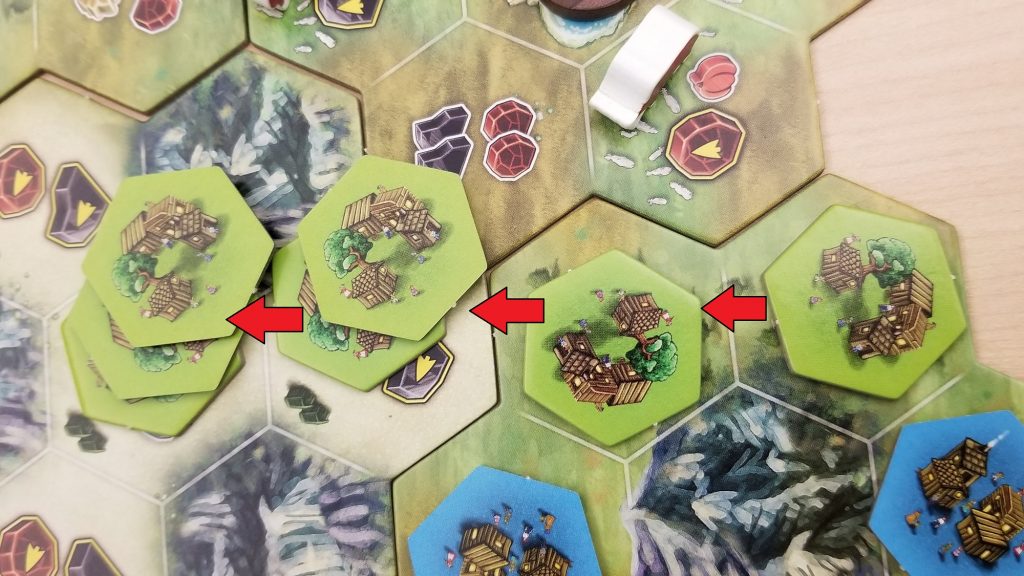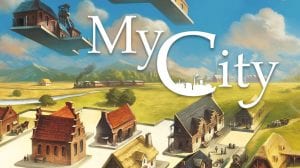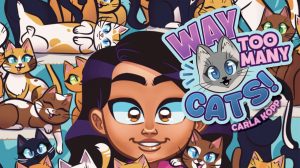Overview
Lying between Wyoming and Canada you will find Montana, looking like a board game box that got damaged during delivery. In the late 19th century, Montana waited, largely uninhabited, while an abundance of raw material lay there ripe for the picking. In Montana, from Rüdiger Dorn, each player will take on the role of a land baron in that time period: herding cattle and working to build up town after town in order to gain the renown needed to win the game.
The goal of the game: head off each opponent and place your final town tile before they are able to place their final tile. But getting to that goal? Therein you’ll find the challenge. Each player will have to make a choice between committing a worker to an action on a central action board in order to gather a commodity, building a town, or building up their workforce in order to make each future action more fruitful. Being a worker placement game, each action taken will have the effect of removing an option for each future worker placed onto the board; tarry too long and the action you were hoping to take might not be there for you. Each choice you make can make you or break you, but if you play competently (and have a little luck), you might pull off the win and become the preeminent citizen of Montana!
Now if you’re only reading my review to find out what I think about Montana, then I implore you to move on down to the “What I Think” portion of my review. If you’re wondering how to play the game, though, then continue reading…
Preparation
Before you can begin playing a game of Montana, you’ve got to prepare your playing area. The layout of your board will change from game to game depending on the player count and which random land tile array you will have picked from the box. In a two-player game, your play area might look like the one pictured here:

Next to the land tile array, you will place the central action board which will be divided up between the bank (where money may be obtained), the mine (copper), the quarry (ore), the grain field (grain), farmland (pumpkin), and the city (which we will get to in a bit). Next to the action board will be placed the worker board which will be how a player will go about building/rebuilding their workforce. In the center of the worker board you will find a dial which, when flicked, will point at an image that will dictate the worker collection that the player will receive.
Each player will elect to play a certain color, place their contractor into the city area of the action board, and then receive everything exhibited in the image below. The total amount of money a player will begin the game with will be dependent upon their place in the turn order.

Then each player will flick the dial twice to determine the makeup of their opening workforce. Now you are ready to begin.
Make Your Choice
On your turn, you will elect to either Recruit, Work, or Build.
Recruiting will require you to flick the dial on the worker board. Once you have collected your reward, you will have the option to pay wheat to move the dial further along in order to collect an additional reward. In the image below, the player will collect one brown and one black worker. If they paid an additional two wheat, they could move the dial twice more and collect an extra yellow and an extra orange worker. A collected worker will be placed onto the appropriate area of the player board. If a worker cannot be placed due to there being no available location, then an idle worker will be removed from the player board to make room for the new one.

Working will involve placing a worker onto an open action on the action board (and paying money) in order to get a commodity in return (ore, for example). The worker placed will have to match the color of the action being taken. If a worker of that color cannot be placed, the player may place a worker of any color followed by another worker of any color. Then the player may opt to do the action once again to gain an extra commodity. In the example below, after paying the three coin, the player will receive a total of 3 ore (2 from the primary action and then one additional commodity).

In the City portion of the action board, an auction will be performed to determine which player will be taking which action. When placing their contractor into a row, the number at the top of the column will depict the total amount, in pumpkin currency, that a player will agree to pay in order to take the action depicted at the end of the row. In the example below, the green player will forfeit three of their pumpkin currency in order to gain up to 3 of either copper, iron, or wheat (or a collection thereof). If an opponent had placed their contractor even one column to the right, the current player would have been forced to bow out of the auction, or move their contractor to a column with a higher pumpkin price tag, or they would have had to opt for a different action on a different row entirely.

In order to Build, pick an area on a land tile and then return one commodity to the bank for each commodity depicted on the area. After paying, you can then place a town tile of your color onto that area after collecting the cattle from that area (if any). If you find an image exhibiting more than one town icon on that area, an additional town tile will be placed in that area. If the initial town tile being placed would complete a chain of four, then yet another town tile will be placed (like in the example below):

If a player managed to place their final town tile on their turn, then the current round will be completed. If that player happened to be the only one that managed to place their final town tile, they will win the game. If multiple people placed a like number, then the winner will be determined by tie-breaker.
What I Think
The artwork in Montana immediately drew my attention. Herr Franz can apparently do no wrong. Gracing the box top, we find an image of a pioneering couple gazing into the future while their children frolic playfully in the background. The image on the front of the box captivated me and took me away to another place and time where life lacked complication – where your home could be found wherever you happened to hitch your wagon. The artwork on each game board and each component only add to the theme without taking away from the overall clarity. Due to the clarity of the iconography, I never once needed to pore over the rulebook vainly trying to figure out anything. The component quality in Montana left me in awe. The cardboard: nice and thick. The wooden facet: chunky, tactile, and beautifully realized. Even the rulebook left nothing wanting.
Initially, I thought I’d hate the worker board with the dial, but even that excited me. The anticipatory thrill of finding out what fate decided you were going to get and having to decide whether or not to devote your wheat to improving your lot or hanging onto it in an effort to build up another town provided me with unexpected choice. And Montana provided me with many a choice during my experience with it. For example, no commodity gathering action could be refilled until every location in that board area had been taken. If I wanted to obtain a certain commodity, I would have to carefully think about the effect that would have on the overall game. Opening up that action area would provide my opponent with a much cheaper alternative to gain the commodity. Did I really want to make gathering that commodity a piece of cake for them or did I want to wait it out and hope they were foolhardy enough to open up the more efficient commodity gathering for me? Would my waiting it out play right into their overall plan?
In Montana, I never felt removed from the experience. I controlled my fate. Each choice that I made rippled throughout the game and affected each choice that came after. I really like that. I can’t find any fault with the game. The complexity of Montana felt challenging, but not overwhelming. From preparation, to teaching, to playing, to teardown, Montana moved at a pretty rapid clip. And more importantly, I had a lot of fun playing it. I don’t anticipate that will ever change. Rüdiger Dorn, if you’re reading my review, thank you for what you do. I find Montana to be a delightful, thrilling experience. You turned my head with your earlier work, Goa, and then you caught my eye with Arkadia. Now you’ve got my full, undivided attention.











Rüdiger Dorn is amazing. Very few games have had as big an impact on me as Jambo.
But this one… I am not sure. I may give it a shot at some point, but I do not think I am going to be driving out to my FLGS tonight to find a copy.
Thanks for the great review.